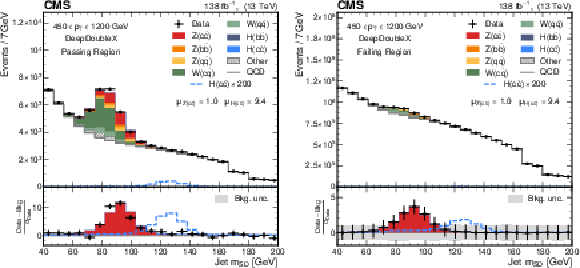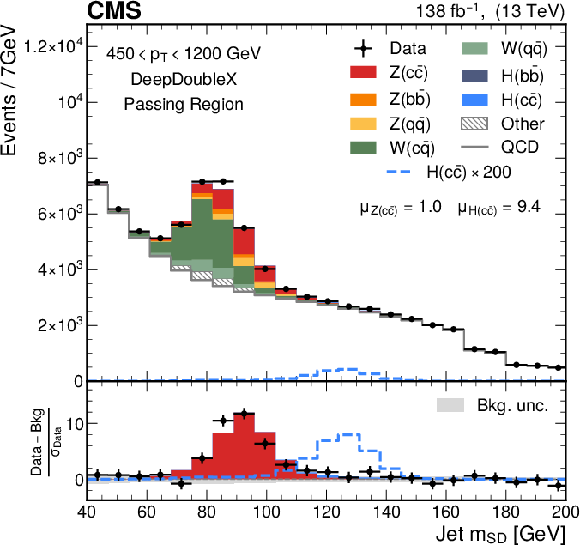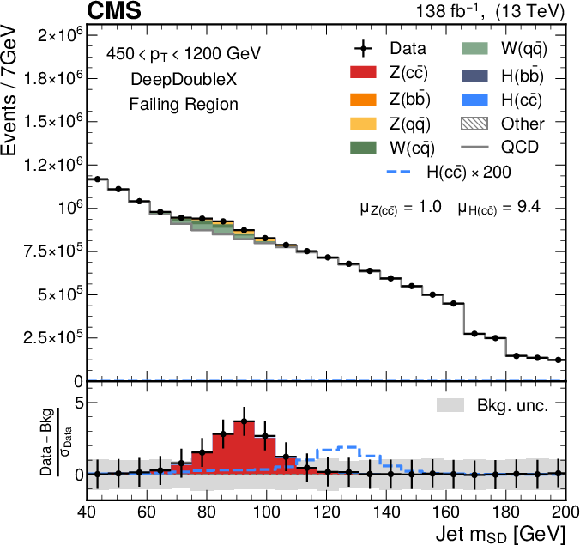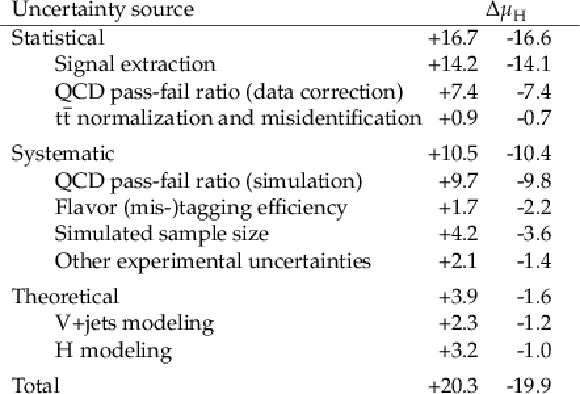

Compact Muon Solenoid
LHC, CERN
| CMS-HIG-21-012 ; CERN-EP-2022-233 | ||
| Search for boosted Higgs boson decay to a charm quark-antiquark pair in proton-proton collisions at $ \sqrt{s} = $ 13 TeV | ||
| CMS Collaboration | ||
| 25 November 2022 | ||
| Phys. Rev. Lett. 131 (2023) 041801 | ||
| Abstract: A search for the standard model (SM) Higgs boson (H) produced with transverse momentum greater than 450 GeV and decaying to a charm quark-antiquark ($ \mathrm{c} \overline{\mathrm{c}} $) pair is presented. The search is performed using proton-proton collision data collected at $ \sqrt{s}= $ 13 TeV by the CMS experiment at the LHC, corresponding to an integrated luminosity of 138 fb$ ^{-1} $. Boosted $ \mathrm{H}\to\mathrm{c}\overline{\mathrm{c}} $ decay products are reconstructed as a single large-radius jet and identified using a deep neural network charm tagging technique. The method is validated by measurement of the $ \mathrm{Z}\to\mathrm{c}\overline{\mathrm{c}} $ decay process, which is observed with a signal strength of 1.00 $ _{-0.14}^{+0.17} $ (syst) $ \pm $ 0.08 (theo) $ \pm $ 0.06 (stat), defined as the ratio of the observed process rate to the standard model expectation. The observed (expected) upper limit on $\sigma (\mathrm{H}) \mathcal{B} (\mathrm{ H \to c\bar{c} })$ is set at 47 (39) times the SM prediction at 95% confidence level. | ||
| Links: e-print arXiv:2211.14181 [hep-ex] (PDF) ; CDS record ; inSPIRE record ; CADI line (restricted) ; | ||
| Figures | |

png pdf |
Figure 1:
The DDCvL and DDCvB performance for $ \mathrm{H}\to\mathrm{c}\overline{\mathrm{c}} $ identification versus QCD and $ \mathrm{H}\to\mathrm{b}\overline{\mathrm{b}} $ processes respectively. No selection apart from the displayed $ m_{\mathrm{SD}} $ and $ p_{\mathrm{T}} $ requirements is applied. The working points used in this search are marked with a cross. The AUC is the area-under-curve metric. |

png pdf |
Figure 2:
The observed and fitted $ m_{\mathrm{SD}} $ distributions for the passing (left) and failing (right) regions, combining all $ p_{\mathrm{T}} $ categories and the three data-taking years. The fit is performed under the signal-plus-background hypothesis with a single inclusive $ \mathrm{H}(\mathrm{c}\overline{\mathrm{c}}) $ signal strength parameter. The $ \mathrm{t} \overline{\mathrm{t}} $ background yields and the QCD background yields and shapes are estimated from data. The $ \mathrm{t} \overline{\mathrm{t}} $ process constitutes the majority of contributions labeled ``Other''. The dashed line represents the $ \mathrm{H}\to\mathrm{c}\overline{\mathrm{c}} $ expectation, multiplied by a factor of 200. The step-like features at 166 and 180 GeV are due to $ m_{\mathrm{SD}} $ bins excluded from the $ \rho $ acceptance region. The lower panel shows the residual difference between the data and the overall background (excluding $ \mathrm{Z}\to\mathrm{c}\overline{\mathrm{c}} $), divided by the statistical uncertainty in the data. The near perfect model agreement with data in the failing region (right) is by construction. |

png pdf |
Figure 2-a:
The observed and fitted $ m_{\mathrm{SD}} $ distributions for the passing region, combining all $ p_{\mathrm{T}} $ categories and the three data-taking years. The fit is performed under the signal-plus-background hypothesis with a single inclusive $ \mathrm{H}(\mathrm{c}\overline{\mathrm{c}}) $ signal strength parameter. The $ \mathrm{t} \overline{\mathrm{t}} $ background yields and the QCD background yields and shapes are estimated from data. The $ \mathrm{t} \overline{\mathrm{t}} $ process constitutes the majority of contributions labeled ``Other''. The dashed line represents the $ \mathrm{H}\to\mathrm{c}\overline{\mathrm{c}} $ expectation, multiplied by a factor of 200. The step-like features at 166 and 180 GeV are due to $ m_{\mathrm{SD}} $ bins excluded from the $ \rho $ acceptance region. The lower panel shows the residual difference between the data and the overall background (excluding $ \mathrm{Z}\to\mathrm{c}\overline{\mathrm{c}} $), divided by the statistical uncertainty in the data. |

png pdf |
Figure 2-b:
The observed and fitted $ m_{\mathrm{SD}} $ distributions for the passing failing region, combining all $ p_{\mathrm{T}} $ categories and the three data-taking years. The fit is performed under the signal-plus-background hypothesis with a single inclusive $ \mathrm{H}(\mathrm{c}\overline{\mathrm{c}}) $ signal strength parameter. The $ \mathrm{t} \overline{\mathrm{t}} $ background yields and the QCD background yields and shapes are estimated from data. The $ \mathrm{t} \overline{\mathrm{t}} $ process constitutes the majority of contributions labeled ``Other''. The dashed line represents the $ \mathrm{H}\to\mathrm{c}\overline{\mathrm{c}} $ expectation, multiplied by a factor of 200. The step-like features at 166 and 180 GeV are due to $ m_{\mathrm{SD}} $ bins excluded from the $ \rho $ acceptance region. The lower panel shows the residual difference between the data and the overall background (excluding $ \mathrm{Z}\to\mathrm{c}\overline{\mathrm{c}} $), divided by the statistical uncertainty in the data. The near perfect model agreement with data in this failing region is by construction. |
| Tables | |

png pdf |
Table 1:
Summary of the applied data-to-simulation scale factors for the jet mass, jet mass resolution, $ N_{2}^{1\mathrm{,DDT}} $ selection, and DEEPDOUBLEX selections for different data-taking periods. The jet mass correction is additive, in units of GeV. |

png pdf |
Table 2:
Sources of uncertainty in the measurement of the signal strength $ \mu_{\mathrm{H}}=$ 9.4$_{-19.9}^{+20.3} $, and their observed impact ($ \Delta\mu_{\mathrm{H}} $) in the fit to the full data set. The impact of each uncertainty is evaluated by computing the uncertainty excluding that source and subtracting it in quadrature from the total uncertainty. The total uncertainty does not match the sum in quadrature of each source because of correlations among the components. |
| Summary |
| In conclusion, a search for standard model (SM) Z and Higgs bosons produced with transverse momenta greater than 450 GeV and decaying to charm quark-antiquark ($ \mathrm{c} \overline{\mathrm{c}} $) pairs has been performed in a data sample corresponding to an integrated luminosity of 138 fb$^{-1}$ at $ \sqrt{s}= $ 13 TeV. New algorithms based on deep neural networks have been developed to identify jets originating from charm quark pairs. The $ \mathrm{Z}\to\mathrm{c}\overline{\mathrm{c}} $ process is observed in association with jets at a hadron collider for the first time, with a signal strength of 1.00 $ _{-0.17}^{+0.19} $ relative to the SM prediction. An observed (expected) upper limit on the product of the Higgs boson production cross section and branching fraction to $ \mathrm{c} \overline{\mathrm{c}} $ of 47 (39) times the SM expectation is set at 95% confidence level. |
| References | ||||
| 1 | ATLAS Collaboration | Observation of a new particle in the search for the standard model Higgs boson with the ATLAS detector at the LHC | PLB 716 (2012) 1 | 1207.7214 |
| 2 | CMS Collaboration | Observation of a new boson at a mass of 125 GeV with the CMS experiment at the LHC | PLB 716 (2012) 30 | CMS-HIG-12-028 1207.7235 |
| 3 | CMS Collaboration | Observation of a new boson with mass near 125 GeV in pp collisions at $ \sqrt{s} = $ 7 and 8 TeV | JHEP 06 (2013) 081 | CMS-HIG-12-036 1303.4571 |
| 4 | CMS Collaboration | Observation of the Higgs boson decay to a pair of $ \tau $ leptons with the CMS detector | PLB 779 (2018) 283 | CMS-HIG-16-043 1708.00373 |
| 5 | ATLAS Collaboration | Measurements of Higgs boson production cross-sections in the $ \mathrm{H}\to\tau^{+}\tau^{-} $ decay channel in pp collisions at $ \sqrt{s}= $ 13 TeV with the ATLAS detector | JHEP 08 (2022) 175 | 2201.08269 |
| 6 | CMS Collaboration | Observation of $ {\mathrm{t}\overline{\mathrm{t}}} \mathrm{H} $ production | PRL 120 (2018) 231801 | CMS-HIG-17-035 1804.02610 |
| 7 | ATLAS Collaboration | Observation of Higgs boson production in association with a top quark pair at the LHC with the ATLAS detector | PLB 784 (2018) 173 | 1806.00425 |
| 8 | ATLAS Collaboration | Observation of $ H \rightarrow b\bar{b} $ decays and VH production with the ATLAS detector | PLB 786 (2018) 59 | 1808.08238 |
| 9 | CMS Collaboration | Observation of Higgs boson decay to bottom quarks | PRL 121 (2018) 121801 | CMS-HIG-18-016 1808.08242 |
| 10 | CMS Collaboration | Search for the Higgs boson decaying to two muons in proton-proton collisions at $ \sqrt{s} = $ 13 TeV | PRL 122 (2019) 021801 | CMS-HIG-17-019 1807.06325 |
| 11 | ATLAS Collaboration | A search for the dimuon decay of the standard model Higgs boson with the ATLAS detector | Phys. Lett. B 812 () 135980, 2021 link |
2007.07830 |
| 12 | ATLAS Collaboration | Search for the dimuon decay of the Higgs boson in pp collisions at $ \sqrt{s} = $ 13 TeV with the ATLAS detector | PRL 119 (2017) 051802 | 1705.04582 |
| 13 | CMS Collaboration | Evidence for Higgs boson decay to a pair of muons | JHEP 01 (2021) 148 | CMS-HIG-19-006 2009.04363 |
| 14 | CMS Collaboration | Performance of deep tagging algorithms for boosted double quark jet topology in proton-proton collisions at 13 TeV with the Phase-0 CMS detector | CMS Detector Performance Note CMS-DP-2018-046, 2018 CDS |
|
| 15 | ATLAS Collaboration | Search for the decay of the Higgs boson to charm quarks with the ATLAS experiment | PRL 120 (2018) 211802 | 1802.04329 |
| 16 | ATLAS Collaboration | Direct constraint on the Higgs-charm coupling from a search for Higgs boson decays into charm quarks with the ATLAS detector | EPJC 82 (2022) 717 | 2201.11428 |
| 17 | CMS Collaboration | A search for the standard model Higgs boson decaying to charm quarks | JHEP 03 (2020) 131 | CMS-HIG-18-031 1912.01662 |
| 18 | CMS Collaboration | Search for Higgs boson decay to a charm quark-antiquark pair in proton-proton collisions at $\sqrt{s}= $ 13 TeV | submitted to PRL | CMS-HIG-21-008 2205.05550 |
| 19 | CMS Collaboration | Inclusive search for a highly boosted Higgs boson decaying to a bottom quark-antiquark pair | PRL 120 (2018) 071802 | CMS-HIG-17-010 1709.05543 |
| 20 | CMS Collaboration | Inclusive search for highly boosted Higgs bosons decaying to bottom quark-antiquark pairs in proton-proton collisions at $ \sqrt{s} = $ 13 TeV | JHEP 12 (2020) 085 | CMS-HIG-19-003 2006.13251 |
| 21 | CMS Collaboration | The CMS experiment at the CERN LHC | JINST 3 (2008) S08004 | |
| 22 | CMS Collaboration | The CMS trigger system | JINST 12 (2017) P01020 | CMS-TRG-12-001 1609.02366 |
| 23 | CMS Collaboration | Performance of the CMS Level-1 trigger in proton-proton collisions at $ \sqrt{s} = $ 13 TeV | JINST 15 (2020) P10017 | CMS-TRG-17-001 2006.10165 |
| 24 | CMS Collaboration | Electron and photon reconstruction and identification with the CMS experiment at the CERN LHC | JINST 16 (2021) P05014 | CMS-EGM-17-001 2012.06888 |
| 25 | CMS Collaboration | Performance of the CMS muon detector and muon reconstruction with proton-proton collisions at $ \sqrt{s}= $ 13 TeV | JINST 13 (2018) P06015 | CMS-MUO-16-001 1804.04528 |
| 26 | CMS Collaboration | Description and performance of track and primary-vertex reconstruction with the CMS tracker | JINST 9 (2014) P10009 | CMS-TRK-11-001 1405.6569 |
| 27 | CMS Collaboration | Particle-flow reconstruction and global event description with the CMS detector | JINST 12 (2017) P10003 | CMS-PRF-14-001 1706.04965 |
| 28 | CMS Collaboration | Performance of reconstruction and identification of $ \tau $ leptons decaying to hadrons and $ \nu_{\!\tau} $ in pp collisions at $ \sqrt{s}= $ 13 TeV | JINST 13 (2018) P10005 | CMS-TAU-16-003 1809.02816 |
| 29 | CMS Collaboration | Jet energy scale and resolution in the CMS experiment in pp collisions at 8 TeV | JINST 12 (2017) P02014 | CMS-JME-13-004 1607.03663 |
| 30 | CMS Collaboration | Performance of missing transverse momentum reconstruction in proton-proton collisions at $ \sqrt{s} = $ 13 TeV using the CMS detector | JINST 14 (2019) P07004 | CMS-JME-17-001 1903.06078 |
| 31 | J. Alwall et al. | The automated computation of tree-level and next-to-leading order differential cross sections, and their matching to parton shower simulations | JHEP 07 (2014) 079 | 1405.0301 |
| 32 | J. Alwall et al. | Comparative study of various algorithms for the merging of parton showers and matrix elements in hadronic collisions | EPJC 53 (2008) 473 | 0706.2569 |
| 33 | P. Nason | A new method for combining NLO QCD with shower Monte Carlo algorithms | JHEP 11 (2004) 040 | hep-ph/0409146 |
| 34 | S. Frixione, P. Nason, and G. Ridolfi | A positive-weight next-to-leading-order Monte Carlo for heavy flavour hadroproduction | JHEP 09 (2007) 126 | 0707.3088 |
| 35 | S. Frixione, P. Nason, and C. Oleari | Matching NLO QCD computations with parton shower simulations: the POWHEG method | JHEP 11 (2007) 070 | 0709.2092 |
| 36 | S. Alioli, P. Nason, C. Oleari, and E. Re | A general framework for implementing NLO calculations in shower Monte Carlo programs: the POWHEG BOX | JHEP 06 (2010) 043 | 1002.2581 |
| 37 | E. Re | Single-top Wt-channel production matched with parton showers using the POWHEG method | EPJC 71 (2011) 1547 | 1009.2450 |
| 38 | R. Frederix, E. Re, and P. Torrielli | Single-top $ t $-channel hadroproduction in the four-flavour scheme with POWHEG and aMC@NLO | JHEP 09 (2012) 130 | 1207.5391 |
| 39 | T. Sjöstrand et al. | An introduction to PYTHIA8.2 | Comput. Phys. Commun. 191 (2015) 159 | 1410.3012 |
| 40 | R. Frederix and S. Frixione | Merging meets matching in MC@NLO | JHEP 12 (2012) 061 | 1209.6215 |
| 41 | S. Kallweit et al. | NLO electroweak automation and precise predictions for W+multijet production at the LHC | JHEP 04 (2015) 012 | 1412.5157 |
| 42 | S. Kallweit et al. | NLO QCD+EW automation and precise predictions for V+multijet production | 50th Rencontres de Moriond, QCD and high energy interactions, 2015 Kallweit in 5 (2015) 121 |
1505.05704 |
| 43 | S. Kallweit et al. | NLO QCD+EW predictions for V+jets including off-shell vector-boson decays and multijet merging | JHEP 04 (2016) 021 | 1511.08692 |
| 44 | J. M. Lindert et al. | Precise predictions for V+jets dark matter backgrounds | EPJC 77 (2017) 829 | 1705.04664 |
| 45 | J. M. Campbell and R. K. Ellis | MCFM for the Tevatron and the LHC | Nucl. Phys. Proc. Suppl. 20 (2010) 5 | 1007.3492 |
| 46 | K. Hamilton, P. Nason, C. Oleari, and G. Zanderighi | Merging H/W/Z + 0 and 1 jet at NLO with no merging scale: a path to parton shower + NNLO matching | JHEP 05 (2013) 082 | 1212.4504 |
| 47 | G. Luisoni, P. Nason, C. Oleari, and F. Tramontano | HW$^{\pm} $/HZ+0 and 1 jet at NLO with the POWHEG box interfaced to GoSam and their merging within MiNLO | JHEP 10 (2013) 083 | 1306.2542 |
| 48 | K. Becker et al. | Precise predictions for boosted Higgs production | 2005.07762 | |
| 49 | E. Bagnaschi, G. Degrassi, P. Slavich, and A. Vicini | Higgs production via gluon fusion in the POWHEG approach in the SM and in the MSSM | JHEP 02 (2012) 088 | 1111.2854 |
| 50 | P. Nason and C. Oleari | NLO Higgs boson production via vector-boson fusion matched with shower in POWHEG | JHEP 02 (2010) 037 | 0911.5299 |
| 51 | H. B. Hartanto, B. Jäger, L. Reina, and D. Wackeroth | Higgs boson production in association with top quarks in the POWHEG BOX | PRD 91 (2015) 094003 | 1501.04498 |
| 52 | CMS Collaboration | Event generator tunes obtained from underlying event and multiparton scattering measurements | EPJC 76 (2016) 155 | CMS-GEN-14-001 1512.00815 |
| 53 | CMS Collaboration | Extraction and validation of a new set of CMS PYTHIA8 tunes from underlying-event measurements | EPJC 80 (2020) 4 | CMS-GEN-17-001 1903.12179 |
| 54 | NNPDF Collaboration | Parton distributions for the LHC run II | JHEP 04 (2015) 040 | 1410.8849 |
| 55 | NNPDF Collaboration | Parton distributions from high-precision collider data | EPJC 77 (2017) 663 | 1706.00428 |
| 56 | GEANT4 Collaboration | GEANT 4---a simulation toolkit | NIM A 506 (2003) 250 | |
| 57 | M. Cacciari, G. P. Salam, and G. Soyez | The anti-$ k_{\mathrm{T}} $ jet clustering algorithm | JHEP 04 (2008) 063 | 0802.1189 |
| 58 | M. Cacciari, G. P. Salam, and G. Soyez | FastJet user manual | EPJC 72 (2012) 1896 | 1111.6097 |
| 59 | D. Bertolini, P. Harris, M. Low, and N. Tran | Pileup per particle identification | JHEP 10 (2014) 059 | 1407.6013 |
| 60 | A. J. Larkoski, S. Marzani, G. Soyez, and J. Thaler | Soft drop | JHEP 05 (2014) 146 | 1402.2657 |
| 61 | CMS Collaboration | Performance of the reconstruction and identification of high-momentum muons in proton-proton collisions at $ \sqrt{s} = $ 13 TeV | JINST 15 (2020) P02027 | CMS-MUO-17-001 1912.03516 |
| 62 | CMS Collaboration | Identification of heavy-flavour jets with the CMS detector in pp collisions at 13 TeV | JINST 13 (2018) P05011 | CMS-BTV-16-002 1712.07158 |
| 63 | M. Dasgupta, A. Fregoso, S. Marzani, and G. P. Salam | Towards an understanding of jet substructure | JHEP 09 (2013) 029 | 1307.0007 |
| 64 | J. Dolen et al. | Thinking outside the ROCs: Designing decorrelated taggers (DDT) for jet substructure | JHEP 05 (2016) 156 | 1603.00027 |
| 65 | ATLAS Collaboration | Measurement of soft-drop jet observables in pp collisions with the ATLAS detector at $ \sqrt{s} = $ 13 TeV | PRD 101 (2020) 052007 | 1912.09837 |
| 66 | I. Moult, L. Necib, and J. Thaler | New angles on energy correlation functions | JHEP 12 (2016) 153 | 1609.07483 |
| 67 | A. J. Larkoski, G. P. Salam, and J. Thaler | Energy correlation functions for jet substructure | JHEP 06 (2013) 108 | 1305.0007 |
| 68 | CMS Collaboration | Performance of the mass-decorrelated DeepDoubleX classifier for double-b and double-c large-radius jets with the CMS detector | CMS Detector Performance Note CMS-DP-2022-041, 2022 CDS |
|
| 69 | M. Sundararajan, A. Taly, and Q. Yan | Axiomatic attribution for deep networks | 34th International Conference on Machine Learning, PMLR, 2017 Proceedings of the 3 (2017) 3319 |
1703.01365 |
| 70 | G. Montavon et al. | Explaining nonlinear classification decisions with deep Taylor decomposition | Pattern Recognit. 65 (2017) 211 | 1512.02479 |
| 71 | J. Thaler and K. Van Tilburg | Identifying boosted objects with N-subjettiness | JHEP 03 (2011) 015 | 1011.2268 |
| 72 | S. Bernstein | Démonstration du théorème de Weierstrass fondée sur le calcul des probabilités | Comm. Kharkov Math. Soc. 13 (1912) 01 | |
| 73 | R. A. Fisher | On the interpretation of $ \chi^{2} $ from contingency tables, and the calculation of P | J. R. Stat. Soc. 85 (1922) 87 | |
| 74 | CMS Collaboration | Jet energy scale and resolution performance with 13 TeV data collected by CMS in 2016–2018 | CMS Detector Performance Note CMS-DP-2020-019, 2020 CDS |
|
| 75 | CMS Collaboration | Performance of heavy flavour identification algorithms in proton-proton collisions at 13 TeV at the CMS experiment | CMS Detector Performance Note CMS-DP-2017-012, 2017 CDS |
|
| 76 | CMS Collaboration | Performance of b tagging algorithms in proton-proton collisions at 13 TeV with Phase 1 CMS detector | CMS Detector Performance Note CMS-DP-2018-033, 2018 CDS |
|
| 77 | CMS Collaboration | Performance of the pile up jet identification in CMS for Run 2 | CMS Detector Performance Note CMS-DP-2020-020, 2020 CDS |
|
| 78 | R. J. Barlow and C. Beeston | Fitting using finite Monte Carlo samples | Comput. Phys. Commun. 77 (1993) 219 | |
| 79 | CMS Collaboration | Precision luminosity measurement in proton-proton collisions at $ \sqrt{s} = $ 13 TeV in 2015 and 2016 at CMS | EPJC 81 (2021) 800 | CMS-LUM-17-003 2104.01927 |
| 80 | CMS Collaboration | CMS luminosity measurement for the 2017 data-taking period at $\sqrt{s} = $ 13 TeV | CMS Physics Analysis Summary CMS-PAS-LUM-17-004, 2018 CDS |
|
| 81 | CMS Collaboration | CMS luminosity measurement for the 2018 data-taking period at $\sqrt{s} = $ 13 TeV | CMS Physics Analysis Summary CMS-PAS-LUM-18-002, 2019 CDS |
|
| 82 | The ATLAS Collaboration, The CMS Collaboration, The LHC Higgs Combination Group | Procedure for the LHC Higgs boson search combination in Summer 2011 | Technical Report CMS-NOTE-2011-005, ATL-PHYS-PUB-2011-11, 2011 | |
| 83 | CMS Collaboration | Measurement of the Z boson differential production cross section using its invisible decay mode ($ \mathrm{Z}\to\nu\overline{\nu} $) in proton-proton collisions at $ \sqrt{s}= $ 13 TeV | JHEP 05 (2021) 205 | CMS-SMP-18-003 2012.09254 |
| 84 | Particle Data Group | Review of Particle Physics | PTEP 2022 (2022) 083C01 | |
| 85 | T. Junk | Confidence level computation for combining searches with small statistics | NIM A 434 (1999) 435 | hep-ex/9902006 |
| 86 | A. L. Read | Presentation of search results: the CL$ _\text{s} $ technique | JPG 28 (2002) 2693 | |
| 87 | G. Cowan, K. Cranmer, E. Gross, and O. Vitells | Asymptotic formulae for likelihood-based tests of new physics | EPJC 71 (2011) 1554 | 1007.1727 |
| 88 | CMS Collaboration | HEPData record for this analysis | link | |

|
Compact Muon Solenoid LHC, CERN |

|

|

|

|

|

|